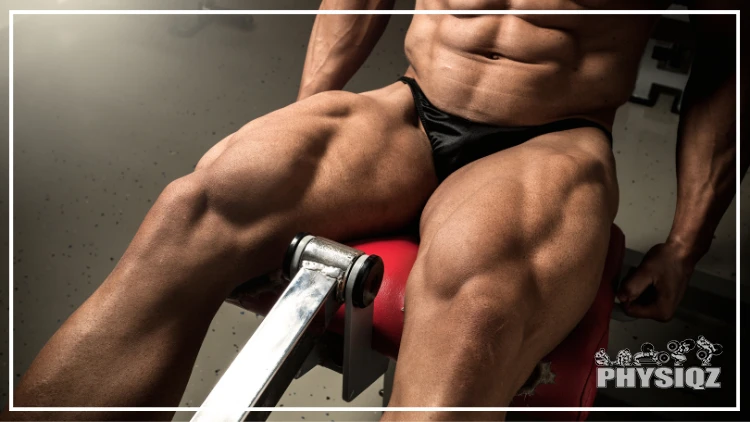
The outer quad is part of the four muscles that make up the quadricep and is the most significant of the muscle group in terms of functionality and appearance; and these 11 outer quad exercises were deliberately chosen to ensure that the outer quad is effectively trained to attain rock-like and fuller legs.1
To achieve a proper targeting of this muscle, these exercises should be done regularly—the big quad expansion secret and trick to hit the outer thighs includes among other things, foot positioning and foot angle but we’ll explain this in depth.
Upon reading this you’ll be equipped with exercises and concepts that will get you the thunder thighs you dream of, and make leg days’ worth the pain.
Can You Target & Isolate the Outer Quads Exclusively?
The outer quads (vastus lateralis) coat the front of the outer leg and cannot be isolated alone by any particular exercise while excluding the other 3 components of the quadriceps; they can however be targeted or emphasized with the exercises that are mentioned below.
On the other hand, only the rectus femoris which is one of the 4 muscles that make up the quads can be isolated—it traverses down the leg and is attached to the patella via the quadriceps femoris tendon and happens to be the only quad muscle to cross both the knee and hip joints—this muscle functions in isolation when flexing the hips.
While a narrower stance doesn’t imply that the quad is being targeted, it does mean however that the quads as a whole are getting engaged more than the glutes; by doing exercises that target the quads primarily such as front squats as opposed to back squats, then the lifter is on the right track to emphasizing them. The most important thing is that the quads are targeted more which will result in the outer quads developing.
Elite bodybuilders have performed outer quad exercises when bodybuilding training; incorporating techniques such as foot placement and varying the stance with results to show for it.
There are certain exercises that can help place emphasis on the outer quads and will develop muscle that will result in a striking quad curvature, a common sight among the top 10 bodybuilders of all time.
Anatomy of Lateral Thigh Muscles & Quadriceps Contour
The quad muscle is composed of four muscles, namely the vastus medialis, vastus intermedius ,rectus femoris and the vastus lateralis with the outer thigh and/or quad being the lateral component of the muscle group and made of both the vastus lateralis and covered by the iliotibial tract (ITB) which is commonly referred to as the IT band.
Vastus lateralis (outer thigh) originates from the upper part of the femur bone (the upper bone of the leg) and terminates at the quadriceps femoris tendon inserting into the upper part of the patella (kneecap) and its primary function is to extend the knee, and stabilize the thighs and knee cap during everyday movements, such as running and walking.2
The outer quad curve is a result of having a well-defined outer quad which makes the leg fuller, bigger and muscular due to the lateral (side) aspect of the quads. This results in the quads forming a bow shape from the hips down to the knees and is a desired trait among bodybuilders helping to give their legs a chiseled appearance.
The outer quad not only provides the side quad with a bolder contour, but creates definition where the rectus femoris anteriorly and in a lateral fashion meets with the hamstring and the tensor fasciae latae (TFL) which lies deep within the IT band.
A comparison between the vastus lateralis vs vastus medialis (VMO), shows that the vastus lateralis differs from the vastus medialis (VMO) in that it is located in the inner part of the quad running along the inner part of the thigh and is a tear dropped muscle.
Like the outer thigh, it connects to the femur but at a lower location and also attaches to the knee cap. The VMO also serves the function of extending the knee and is instrumental in ensuring the patella tracks correctly.
It is often the biggest culprit and contributor to knee pain due to either weakness and /or fatigue.
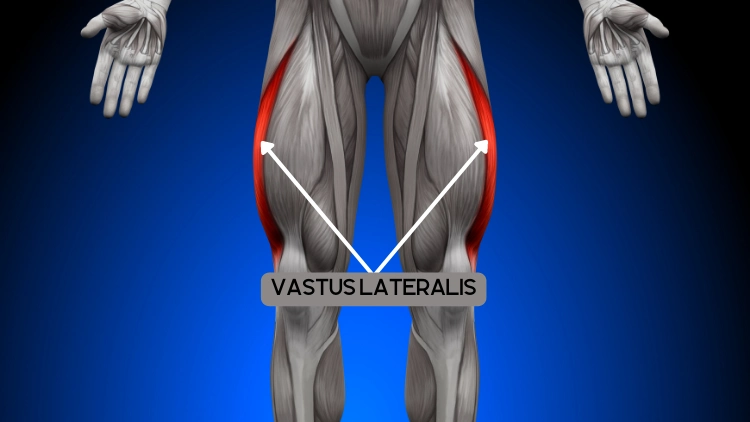
Source: decade3d via Canva.com3
Top 11 Outer Quad Exercises for a Big Quad Contour (Outer Thigh Workouts)
There are a number of outer quad isolation exercises that can help target the outer quads effectively to help them grow in mass, get more toned and get that coveted big sweep that will give the lifter a completely balanced and aesthetic physique; these exercises range from using barbells, dumbbells, and machines such as leg extensions and presses.
Each type of exercise, whether barbell or assisted by the use of machines presents different advantages that all contribute to helping achieve vastus latein should be included in the nutrition of a lifter; examples of these are chicken breasts, legumes, eggs, cheese etc.ralis hypertrophy (muscle growth).
While there are many lower body exercises that can help develop the outer quads such as back squats, the below are the best exercises on how to strengthen quads because they are effective at targeting the outer quads more than the other secondary movers in the movement, based on studies:
- Front squats
- Leg extensions
- Narrow stance leg press
- Barbell walking lunges
- Bulgarian squats and
- Smith machine squats at an angle
1. Front Squat
The front squat is a compound exercise (involving multiple muscle groups) and a variation of the traditional and staple back squat. It has the lifter hold the barbell in front of the chest on the clavicles (shoulder blades) placing it directly above the quads.
As a result of what seems like a minute change, the impact of weight distribution is significant, as it demands more from the quads than it does the glutes, making it one of the best quad exercises for mass. The positioning of the bar reduces the shearing forces acting on the knee and also places less stress on the spinal column.4
How to perform front squat: To begin the exercise, the lifter should stand in front of a squat rack, walk under the bar and position the barbell onto the clavicles. They should then lift their arms, bend their elbows and proceed to hook their thumbs under the bar and then push up with their legs to lift the weight and take 2-3 steps back.
To descend, they should bend beginning with the hips and lower to parallel where knees are approximately 90 degrees. Once at the bottom phase, they should then drive using both legs to get back into the starting position.
Tips to emphasize the outer quad: A tip to make the front squat more intense and if mobility allows, is to adopt a narrow stance which will emphasize the outer quads even more.
The lifter can also slow down the lowering phase known as the eccentric, making them a type of eccentric quad exercises which will keep the outer quads under more tension to stimulate growth.

Source: Leon Ardho via Pexels5
2. Leg Extensions
The seated leg extensions, unlike the squat, are an isolation exercise which ensures that the quads as a whole are isolated in the exercise, outer quads included.
By taking out other muscle groups such as the glutes and hamstrings which are involved in compound movements like the squats, leg extensions will ensure that there is no compensation for weak quads by other muscle groups ‘helping’ in the movement.
Many times, lifters have weaker quads than hamstrings and glutes causing muscular imbalances that could lead to injuries; by performing leg extensions, individuals can rid themselves of smaller and weaker outer and inner quads.
How to perform leg extensions: Proceed to sit on the leg extension machine making the necessary pad and height adjustments—to do this, ensure that the bottom pad is above the lower legs at the ankles and knees should be bent and angled at 90 degrees.
After selecting a manageable weight, commence by gripping the handles to ensure stability and while maintaining a neutral spine and looking straight ahead, lift the ankle pad by squeezing the quads to extend the knees.
Pause once knees are extended, but neither locked out nor hyperextended for 1-2 seconds and slowly lower weight back to the start and complete desired reps.
Tips to emphasize the outer quad: To make this movement more outer quad dominant, the feet can be turned inwards at a subtle angle; less than 45 degrees. This will however place more stress on the knees and the lifter should start lighter than they would when neutral.
Those with knee issues should have the feet remain neutral if discomfort persists.
3. Leg Press (Narrow Stance)
Leg press is a compound exercise that targets and can isolate the leg muscles in a similar movement as the squat, however there is less stress placed on both the back and core muscles. This exercise is a viable accessory exercise that can supplement a back squat workout program by allowing for a myriad of variations brought on by shifting leg angles.
The leg press elicits the greatest activation on both the vastus lateralis (outer quad) and the vastus medialis (inner quad) which is delightful news for those looking for well-defined quads and is an ideal outer quad workout; it also doubles as among the inner quad exercises.6
Using the leg press to squat conversion, a lifter can determine what weight to decide when moving from squats to leg presses and vice versa.
How to perform leg press: The lifter should start by sitting on the seat with their back against the backrest, ensuring knees are bent and feet are placed on the platform.
The position of the feet should mimic the placement when squatting depending on the individual, and should be in the lower half of the platform to place an emphasis on the fronts of the legs.
They should then unlock the platform and push away until the legs are almost straight and the knees should not be locked out with the legs having a slight bend. Pause at this position then bring the weight back to the start position with knees bent and at the chest and repeat for desired reps.
Tips to emphasize the outer quad: Keep the feet at the bottom of the footpad and have the legs closer which will result in an emphasis on the outer quads, rather than on the glutes and hamstrings resulting in an impressive quad definition.
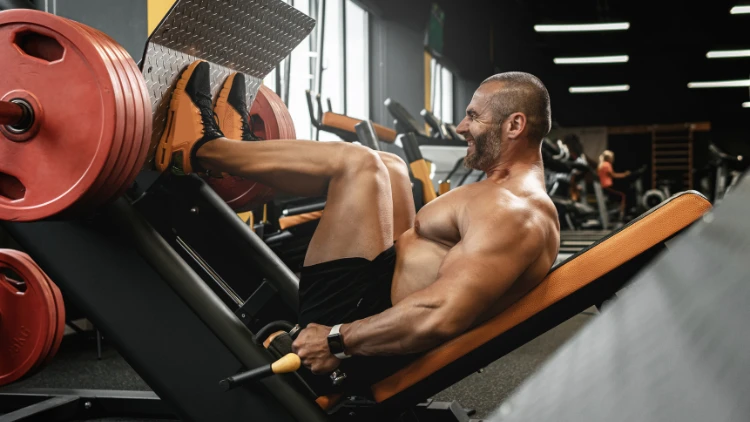
Source: A’s Images via Canva.com7
4. Barbell Walking Lunges
Barbell walking lunges are an excellent lower body compound movement that emphasizes different areas of the lower body and can be used to place an emphasis on the outer quads with some modifications, making them worthwhile outer quad exercises.
This exercise can also be done with dumbbells and in addition to developing the quads, they do serve as a functional exercise that enhances balance and coordination.8
How to perform barbell walking lunges: Once in an area that will allow space to walk with the barbell and / or dumbbells, place the bar across the traps and place the feet at shoulder width.
Engage the core and take one step forward with one leg while concurrently bending the knees of both legs allowing the lifter into a lunge position—the knees should be bent until they are almost touching the floor.
Proceed to stand up and move the back leg forward until it is the front leg. Repeat for desired reps.
Tips to emphasize the outer quad: Walking lunges can become a more outer quad dominant movement by taking smaller steps that will result in a shift forward of the weight and engage the quads more. If larger steps are to be taken, the glutes will become heavily involved.
5. Dumbbell Forward Lunges
These lunges which are part of dumbbell quad exercises are done in a somewhat dynamic position but there is no walking as with walking lunges—they highly emphasize the outer quads which perform the function on knee extension. As they are a unilateral exercise, they also help the lifter improve balance, core strength and coordination.
How to perform barbell walking lunges: While grabbing two dumbbells with palms facing inward, stand tall and ensure feet are roughly hip width.
Brace the core, while taking a step forward with the knee slightly bent and proceed to lower the torso by bending both knees such that the front knee is bent at a 90 degree angle with the back knee slightly above the ground.
Proceed to push the front foot to engage the quads to lift the body upward to step the feet back together. Complete for one side, then proceed to the other for desired reps.
Tips to emphasize the outer quad: Taking smaller steps here will engage the outer quads more than they do the glutes.
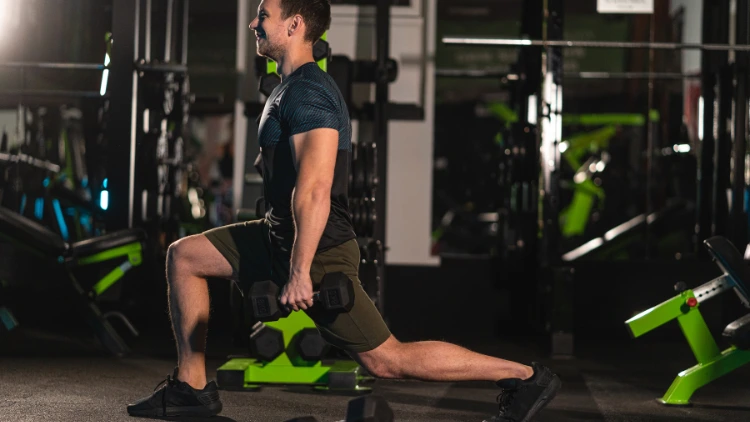
Source: Charli Bandit via Canva.com9
6. Bulgarian Split Squats
The Bulgarian split squat is similar to dumbbell forward lunges but is more of a static movement; like the dumbbell forward lunges, they are a unilateral exercise that help improve balance, coordination and help reduce muscle imbalances, are one of the squat accessory lifts and can be included in the Bulgarian squat method.
How to perform Bulgarian split squats: Stand in front of a bench with feet placed width apart and grab two dumbbells, although kettlebells and barbells can also be used. Place one foot forward to get into a split position while carefully lifting the back leg and rest the top of the back foot on the bench.
While standing straight, brace the core, maintain a neutral back, maintain a straight gaze and keep the chin tucked.
Begin by bending the front knee such that both legs are descended to the ground and stop when the front knee is bent at a 90 degree angle whilst the back knee is slightly above the ground. Drive through the front foot to engage the quads and lift back to the starting position.
Complete on one side and switch to the other leg.
Tips to emphasize the outer quad: By shortening the stance, the lifter can place emphasis on the front of the legs resulting in more activation of the quads, including the outer quads. In case the lifter has a weaker side, they should commence with the weaker side.
7. Dumbbell Split Squat
Dumbbell split squats are similar to the dumbbell lunges except for one main difference, during the split squats, the lifter moves either forward or backward, whereas in a split squat, the movement is up and down. The outer quads are highly engaged in this movement as are the glutes, but a modification can help target the outer quads better.
How to perform dumbbell split squat: Grab two dumbbells and or /barbell and place the feet staggered, with one in front of the other similar to a lunge stance. Engage the core muscles, then bend both knees descending into a split squat and the lifter should bend until the back knee barely touches the floor.
The front foot remains flat but the back foot is on the toes. Raise the torso by pushing through the feet and stand up.
Finish one side, then proceed to the other leg.
Tips to emphasize the outer quad: As with the barbell walking lunge, a shorter stride distance between the feet will place more emphasis on the quads, therefore the distance between the feet should be shortened.
8. Smith machine squats at an angle
Smith machines are among the quad machines at the gym that allow the lifter to squat without having to use free weights, which takes out the need to balance and coordinate the barbell resulting in less engagement of stabilizer muscles.
Angled machines have the bar travel vertically at a 7-12 degree angle, with this slight incline allowing for a more natural bar path. For those concerned about the effectiveness of smith machines for lower leg workouts, they are actually a versatile addition and component of a leg workout regimen.
The quadriceps are the most heavily engaged muscle group with the glutes, hip adductors and lower back playing auxiliary roles. The outer quads are highly targeted in this movement and since balance has been taken out of the equation, the quads get a solid workout.
How to perform Smith machine squats at an angle: With the body facing away from where the bar is angled, the smith bar should be at the same level as the shoulders of the lifter and located on the delts and upper traps when standing. The lifter should start by getting under the bar and position the hands shoulder width.
They should step forward 3-6 inches which will lead to the feet being in front of the knees but the lifter can adjust to get the most comfortable position due to differing anatomies.
To begin the descent, unhook the bar and rotate wrists ensuring hooks remain out of the way, inhale and push hips back to begin bending at the knees (hip flexion) while keeping the chest up and shoulders back and retracted.
The ideal depth is past parallel, unless there are mobility issues and at this point the knees should align with the toes, and back neutral with no arch.
Exhale and then ascend by driving the feet, elbows should remain pointed, and core engaged. Repeat for desired reps.
Tips to emphasize the outer quad: By narrowing the stance, the lifter can activate the outer quads although the lifter doesn’t need to go very narrow. Oftentimes, when the feet are too apart, the movement becomes more abductor focused.
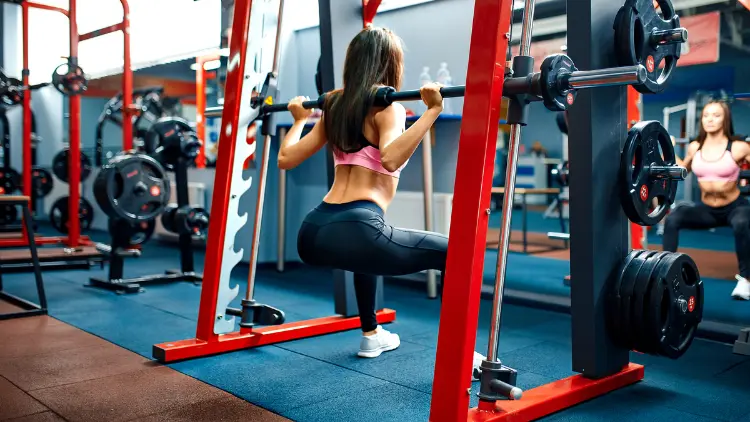
Source: Aleksandr Zamuruev / 500px via Canva.com10
9. Belt Squat
The belt squat is an apparatus that allows the lifter to load the weight on a belt on the waist as opposed to their upper traps and shoulders, which delivers less stress and load on the spine and reduces the compressive forces on the knees.11 Belt squatting also results in an increased activation of the quads while engaging the hip extensors less.
How to perform belt squat: To begin, lifters should step on the belt machine and wrap the belt around waist after having selected their desired weight. They then hook the weight belt to the chain and stand up.
Release the safety bar and commence the movement by hinging at the hips until they form a 90 degree angle with the platform. Proceed to push up with both legs until upright, and complete desired reps.
Tips to emphasize the outer quad: By maintaining a slow and gradual lowering and pushing up with the quads will lead to increased time under tension (time under which a muscle is under tension under a load) for the outer quads resulting in outer quad growth.
10. Hack Squat
The lifter uses a hack squat machine to perform this exercise by locking the lower hips and has the back into the machine, leaving the body with no choice but to fully engage the quads. This contraption was invented by George Hackenschmidt who was an old school lifter and wrestler and had advanced front thigh development partially due to using this machine.
How to perform the hack squat: The lifter should stand on the platform with the feet planted hip width apart and toes pointing forward. The back should be against the backrest and shoulders under the pads and should extend the legs, releasing the safety catches.
To begin the descent, bend the legs and squat down, permitting the knees to move forward and ensure the back is firmly pressed into the backrest. Ascending is accomplished by driving feet into the floor and returning to the starting position.
Tips to emphasize the outer quad: A hip width stance will emphasize the outer quads. To increase the intensity and load on the outer quads, the lifter may rise up to their toes as they descend.
They could also keep the hips back and drive the knees forward to intensify the engagement of the quads. Squeezing the quads at the top of every rep will go a long way to enhancing and intensifying the workout.
11. Sissy Squat
This uniquely named exercise is from the old era of bodybuilding; it employs only body weight and is highly intense on the quads making it a great option on how to target outer quads.
Sissy squats are great because they can be done anywhere since no equipment is needed to perform them—they can easily be included in a beginner hypertrophy program as an accessory to the main compound movements.
How to perform the sissy squat: The lifter stands by a wall and / or an object that can help with balance and rises up onto their toes. To descend, they should then push the hips and knees forward to squat down while simultaneously leaning back and descend as far as possible until the shins are parallel to the ground.
Ascending involves driving into the floor and standing back up. Quads and glutes should be tensed at the beginning positioning.
Tips to emphasize the outer quad: Taking a narrow stance will help emphasize the outer quad to develop an impressive quad definition.
Factors To Optimize When Growing Your Quads
In addition to performing the aforementioned exercises, the lifters will need to optimize aspects of their training program that will complement the strength training, allowing them to achieve the glorious and coveted well-defined quadriceps. These these include maintaining sufficient calorie intake, consuming enough protein, ensuring enough exercise frequency and paying attention to the range of motion (ROM).
Sufficient Calories
When a lifter is looking to build mass in their quads and indeed their entire body, they must consume more calories. Individuals should increase calorie intake by 350-450 kcal daily to effectively build muscle. 12
While lifting weights doesn’t necessarily burn as many calories as many cardio workouts, the increased muscle mass that is developed enhances the muscle-to-fat ratio. Muscle requires higher calories to maintain and this in turn increases the calorie burn throughout the day and not only during the workout.
Adequate Protein
When muscle is broken down as a result of strength training, the body will require protein in adequate amounts because protein contains amino acids such as leucine, dileucine, isoleucine, valine and branded-chain amino acids (BCAA’s) that the body needs to build and repair the muscle broken down during resistance training.13
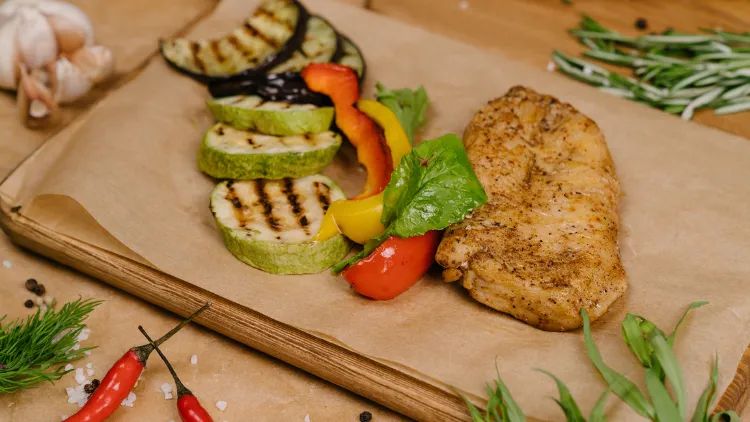
Source: Алекке Блажин via Pexels14
The ideal amount of protein that should be consumed by those who are active in strength training is 1.2-2 grams of protein per kilogram of bodyweight—a person weighing 150 lbs. should roughly consume 55 grams of protein daily.15 High quality sources of protein should be included in the nutrition of a lifter; examples of these are chicken breasts, legumes, eggs, cheese etc.
Adequate Volume
Training volume is a measure of the total weight lifted during a workout and computed by multiplying the weight by the number of sets and reps. High training volume has been proven to be the most effective stimuli to achieve muscle growth—to achieve that desired quad definition, lifters must put in adequate volume when performing outer quad exercises.16
Ensuring Enough Exercise Intensity
Intensity refers to the quantity of resistance that the muscle is receiving and is quantified as a percentage of the 1RM (one rep max as the maximum weight that can be lifted over one rep).
Overload principle of any exercise regimen demands that to bring about physiological changes (muscle growth), exercise stimuli must be applied to a muscle with greater intensity than what it is used to. Failure to do this results in training plateaus where the lifter does not make any progress in muscle growth.
Therefore, to achieve hypertrophy, it is recommended to perform 6-12 reps as the best rep ranges mass hypertrophy strength routine in the intensity of 67-85% of the 1RM. The lifter will then adjust this percentage as their 1RM rises.
Altering the volume and intensity as in a daily undulating periodization program will help stave off training plateaus.
Reps in Reserve
Reps in reserve (RIR) refers to the quantity of reps that a lifter can perform in a given set after completing the set, essentially how many more reps they can do before reaching failure. It has become a technique at which lifters can gauge the intensity of a lift. RIR is usually employed alongside the rating of perceived exertion (RPE), which is a measure used in lifting to gauge the intensity of the exercise.
REP is an inverse of the RIR. To elaborate, by way of example, if a lifter who has completed one rep, their RIR would be 10 since they can do 10 more reps before failure, but their REP would 1—when they reach 9 reps, their RIR would 2 since they cannot go further than 11 reps, but their REP would be 9 at that point in time.
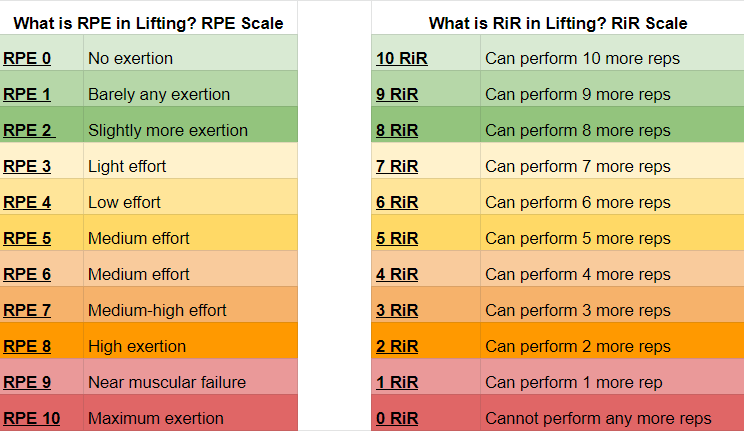
While it is beneficial to train to failure to reach certain training goals, doing it always will cause some changes in resting hormonal concentrations which may lead to compromises in strength brought on by overtraining.17 Therefore, lifters should be working towards failure, but not always making it the norm, as their RIR increases.
Range of Motion
Strength training is a science, and not something left to chance and lifting weights through a full range of motion (pushing and/or pulling a weight as far anatomically possible) will result in a greater activation of the target muscle.18 It will also ensure joint stability and maintain better muscle balance.
With that said, after doing the full version (ROM), bodybuilders performing partial ROM’s will lead to engorging their muscles with blood for a ‘pump’—studies have shown that men who squat at full ROM half the time and the other half squat partial ROM’s had superior strength and muscle mass compared to their counterparts who only squatted full ROM. 19
Maintaining Exercise Frequency
The outer quads must be trained sufficiently to grow them as long as they are allowed to recover between these sessions. Studies have shown that training frequencies of at least twice a week will promote superior muscle growth (hypertrophy).
Lifters can train their outer quads thrice a week but should allow for recovery for those concerned about overtraining their legs by training them three times a week.20
Adequate Rest & Sleep
It is imperative to ensure that the outer quads are given sufficient time to recover; giving the outer quads 48 hours is sufficient for recovery and since the lifter will be working them at least twice a week, they can use split days where a training week can consist of two upper body and two lower body days as in a 4 day workout split regimen.

Source: Kampus Production via Canva.com21
Likewise, getting enough sleep is important and lifters should strive to get 7 hours of continuous sleep, failure to get sufficient sleep will impair muscle strength that could lead to less effective outer quad exercises hampering their efforts to get impressive outer sweeps.22
However, for those curious about whether 6 hours of sleep is sufficient to build muscle compared to 7 hours, it will all depend on genetics—some studies have proven that some individuals require only 4 hours of sleep!
Improving Ankle Mobility & Tight Hips
Ankle mobility is one of the major reasons many people do not excel at leg exercises and are not able to do them effectively. When the ankles are mobile and flexible, the torso can be in a more upright position resulting in an increased focus on the quads.
Ankle stretches and performing either Asian squats vs Slav squats regularly will help mobility.
Tight hips will result in limited range of motion for the hips, which will subsequently make the glutes and hamstrings take the brunt of the load, taking away from the quads activation. Hip stretching is essential to having efficient leg workout mechanics.
Tips on How To Target the Outer Quad Curve (Big Sweep Secret Revealed)
In addition to the optimization factors mentioned above, there are certain tips that can solidify a lifter’s journey to getting imposing thigh muscle definition during the actual exercises; the big secret to achieving impressive quadriceps definition revealed includes varying stance widths, foot angles, stacking the joints, and ensuring a mind-muscle connection.
Stance Width
Having a narrower stance width places more emphasis on the quads especially when other secondary muscles such as glutes are involved in the movement. However, if a lifter is having difficulty due to knee pain, they may lower the weight to get more accustomed to the narrower stance.
Foot Angle
The foot angle though a subtle change can have a profound impact on emphasizing the outer quad. Pointing the toes inward places more emphasis on the vastus lateralis (outer part of the quad) making for a viable vastus lateralis workout, and pointing them inwards targets the vastus medialis (inner quad that forms the teardrop muscle).
Step Width
This is the measured distance between the heels when in stance. By having a smaller distance between the heels, the lifter will target the outer quads better.
Mind Muscle Connection
Having a mind muscle connection will go a long way in engaging and activating the target muscle. Mind muscle connection is essentially feeling or paying mind to the target muscle as the lifter exercises.
The tips below will help in establishing the mind muscle connection:
- Moving slowly to give muscles time to contract.
- Visualizing the muscles contract as you exercise.
- Focus on cues to activate muscles; for example, in squats focus on centering weight and driving through heals to engage the outer quads.
Stacking Joints
Stacking joints ensures that they are properly aligned guaranteeing efficient transmission of force from the ankles to the knees and pelvis causing the outer quads to be properly engaged.
An analogy to this would be the bench press; when the wrist joint is not stacked or aligned with the elbow joint, it becomes harder to produce force and bent wrists become weaker and prone to pain and injury.
Similarly, the knees have to be aligned or stacked above the ankles to ensure maximum force producing better results.
Heels Raised
Elevating the heels is an effective way to place more focus on the outer quads. This is because the range of motion is increased at the knees while being reduced at the hips; as a consequence, the outer quads are activated for a longer period of time which is why sissy squats are effective.
A slant board and / or weight plates can be used when performing back and front squats.
Range of Motion
Researchers from the University of Miami have shown varying activation of muscles in different ranges on motion—when lifters are performing leg extensions, the outer quads are targeted more in the middle ROM which is about 120-150 degrees—for reference, during the start, the knees are at 90 degrees and when legs fully extended at 180 degrees.23
Therefore, to have the outer quads receive more focus, in addition to the full ROM sets, do 2-3 sets at just the first half of the range of motion.
Leg Position On Leg Press Machine
Placing the feet on a lower position on the foot pad during leg presses will result in a change of the loading pattern to be transferred more to the outer quads. However, those with knee issues will need to be careful before embarking on this.
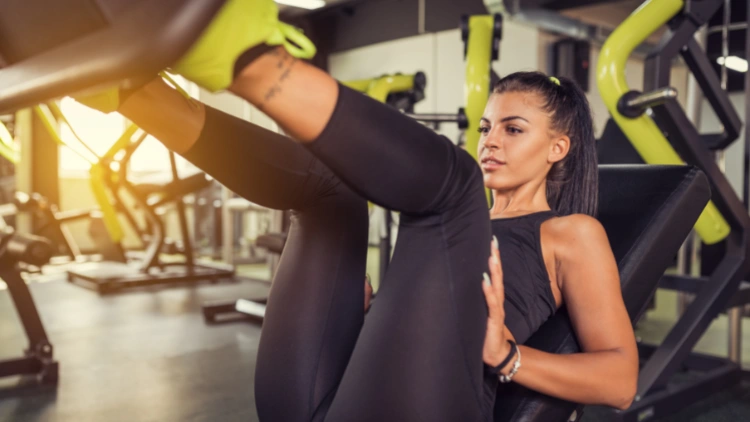
Source: bulatovic via Canva.com24
Pros of Strong Quads & Cons of Weak Legs
Having strong quads and legs is beneficial not only in the gym to effectively and efficiently complete other lower body movements, but carries over to everyday activities such as walking and running; having weak legs makes people more prone to injury and/or developing degenerative diseases especially as they get older.
Pros of Strong Quads
The following are the pros of stronger quads:
- Aesthetic reasons—there is no denying the fact that the thigh contour is a display of appealing definition and gives the lifter a complete and balanced physique especially when coupled with an equally impressive upper body.
- Muscle mass—the outer quad is the longest of the 4 muscles that make up the quad, therefore training it will have a significant impact on overall leg mass and adds to the overall physique.
- Increased lower body strength—improved power in the lower body will carry over to other gym activities by helping them at getting stronger in other workouts by providing a stable platform. In addition, daily activities such as sitting, playing sports and walking become easier to perform. Lifters need to be sure not to neglect the hamstrings and glutes as they work in tandem with the quads.
- Improved knee health—stronger quads will lead to less knee loads and they do protect the knee from injury by bearing the brunt of the load. Weak quads will almost always lead to knee pain over time with research having been carried out to prove this.25
Cons of Weak Legs
The following are the cons of weak legs:
- Increases risk of injury—when the quads are weak, the load demands have nowhere else to go but the joints, particularly the knee. This will make them prone to injury especially as individuals get older.
- Strength loss—weak quads will make other lower leg exercises much harder to perform including squats, lunges and movements that involve pushing with legs more challenging.
- Muscle imbalances—weaker quads that are not able to function at their intended capacity will result in other muscles compensating to extend the knees. This will result in an overall dysfunction and in many cases simple tasks such as climbing stairs, sitting down, standing up and walking become impaired. Pain could set in which could lead to muscle inhibition (improper or restricted function).25
Quadriceps-Focused Leg Day Workout Routine
This leg day workout routine, similar to a 6 day workout routine plan, is designed to have the heavy rep ranges proceed the lighter rep ranges because of the training fatigue that results from both forms of training.
The damage that occurs to the muscles and connective tissues is more substantial and there is higher risk of injury if a lifter is already pre-damaged from lighter work and then proceeds to heavier loads.
Sequencing the workouts from heavy to moderate and finally to light is the advisable strategy. This routine is for five weeks and gives a routine for 3 leg days per week and is a percentage of a lifter’s 1RM.
To build a bigger and stronger quad shape, it is recommended to perform 8 sets of exercises that directly target the quads per week—there should be sufficient rest between training days.
Week 1
- Day 1: Front Squat – 3 sets of 5 reps at 80% of 1RM (1 Rep Max)
- Day 2: Bulgarian Split Squats – 2 sets per side of 10 reps at 70% of 1RM (1 Rep Max)
- Day 3: Leg Extensions (Toes In) – 2 sets of 20 reps at 30% of 1RM (1 Rep Max)
Week 2
- Day 1: Front Squat – 4 sets of 4 reps at 85% of 1RM (1 Rep Max)
- Day 2: Bulgarian Split Squats – 2 sets per side of 12 reps at 60% of 1RM (1 Rep Max)
- Day 3: Leg Extensions (Toes In) – 2 sets of 25 reps at 30% of 1RM (1 Rep Max)
Week 3
- Day 1: Front Squat – 5 sets of 4 reps at 85% of 1RM (1 Rep Max)
- Day 2: Bulgarian Split Squats – 3 sets per side of 12 reps at 60% of 1RM (1 Rep Max)
- Day 3: Leg Extensions (Toes In) – 2 sets of 30 reps at 25% of 1RM (1 Rep Max)
Week 4
- Day 1: Front Squat – 4 sets of 3 reps at 85% of 1RM (1 Rep Max)
- Day 2: Bulgarian Split Squats – 3 sets per side of 10 reps at 70% of 1RM (1 Rep Max)
- Day 3: Leg Extensions (Toes In) – 2 sets of 20 reps at 35% of 1RM (1 Rep Max)
Week 5 (Deload)
- Day 1: Front Squat – 3 sets of 3 reps at 70% of 1RM (1 Rep Max)
- Day 2: Bulgarian Split Squats – 2 sets per side of 8 reps at 60% of 1RM (1 Rep Max)
- Day 3: Leg Extensions (Toes In) – 2 sets of 15 reps at 30% of 1RM (1 Rep Max)
A pronounced quad curvature is one of the most impressive features of the lower body and gives the lifter a balanced and more complete physique, performing these 11 outer quad exercises will help someone achieve aesthetic leg muscles; the big quad curvature secret is to follow cues such like leg placement, foot angle, and stance width to effectively target this muscle.
Frequently Asked Questions
What Is a Quad Sweep?
The quad sweep is the distinctive shape that resembles a bow on the quadriceps muscles due to the outer quads providing a wide lateral feature giving the appearance of a fuller shape of the overall quadriceps muscles physique.
What Exercises Stretch the Quads?
While lying on the back, lift the first leg by bending at the knee and using both hands, gently pull the knee towards the chest. Hold for 30 seconds, release and repeat with the other leg.
A second way to do this would be while standing up; stand on one leg, knees touching and hold a wall and /or a chair for balance. Grab one foot and pull it towards the glutes while pushing the chest up and hips forward.
There should be a feeling of stretching and this position should be held for 30 seconds. Repeat the same process with the other leg.
The third way to do a quad stretch would be to do them while kneeling to help loosen the muscles above the knee. Get into a high lunge position with the right foot forward.
With care, drop the left knee to the floor and ensure that balance is maintained. When ready and balanced, reach with the left arm to grab either toes or ankle.
The position should be held for 30 seconds while keeping the body as steady as possible. Someone can push further to get the hips stretched.
Return to the starting position and switch to the left foot.
What’s the Best Way To Target the Outer Quads on Leg Presses?
On the leg press, the best way to emphasize the outer quads on the leg press is to maintain a narrower stance and also placing the feet low on the foot pad which will shift the focus away from both glutes and hamstrings and towards the outer quads.
References
1JRP Studio. “Bodybuilder’s Quads.” Canva. Accessed 15 April 2023. <https://www.canva.com/photos/MAEvUaqlJhk-bodybuilder-s-quads/>
2Bordoni, B., & Varacallo., M. (2022, May 10). Anatomy, Bony Pelvis and Lower Limb, Thigh Quadriceps Muscle. Retrieved 2023, from <https://www.ncbi.nlm.nih.gov/books/NBK513334/>
3decade3d. “Vastus Lateralis – Anatomy Muscles.” Canva. Accessed 15 April 2023. <https://www.canva.com/photos/MAC_UnLXRks-vastus-lateralis-anatomy-muscles/>
4Jonathan C Gullett, M. D. (2009, January). A biomechanical comparison of back and front squats in healthy trained individuals. Retrieved 2023, from <https://pubmed.ncbi.nlm.nih.gov/19002072/>
5Leon Ardho. “Woman Lifting Barbell.” Canva. Accessed 15 April 2023. <https://www.canva.com/photos/MADlI_GCjS8-woman-lifting-barbell/>
6Isabel Martín-Fuentes, J. M.-L. (2020, June 27). Evaluation of the Lower Limb Muscles’ Electromyographic Activity during the Leg Press Exercise and Its Variants: A Systematic Review. Retrieved 2023, from <https://www.ncbi.nlm.nih.gov/pmc/articles/PMC7369968/>
7A’s Images. “Bodybuilder Doing a Seated Leg Press Exercise in a Gym.” Canva. Accessed 15 April 2023. <https://www.canva.com/photos/MAE2-gMUdmQ-bodybuilder-doing-a-seated-leg-press-exercise-in-a-gym/>
8Academy, A. F. (2020, April 8). 8 LUNGE VARIATIONS TO BUILD LEG STRENGTH. Retrieved 2023, from <https://www.fitnesseducation.edu.au/blog/fitness/8-lunge-variations-to-build-leg-strength/>
9Charli Bandit. “Young man practicing walking lunge with dumbbell.” Canva. Accessed 15 April 2023. <https://www.canva.com/photos/MAEJAH6izks-young-man-practicing-walking-lunge-with-dumbbell/>
10Aleksandr Zamuruev / 500px. “Athletic Young Woman Doing Deadlift Exercise In The Smith Machine.” Canva. Accessed 15 April 2023. <https://www.canva.com/photos/MADpM7bo9Mc-athletic-young-woman-doing-deadlift-exercise-in-the-smith-machine/>
11Lori Joseph, J. R. (2020, March 31). Activity of Trunk and Lower Extremity Musculature: Comparison Between Parallel Back Squats and Belt Squats. Retrieved 2023, from <https://www.ncbi.nlm.nih.gov/pmc/articles/PMC7126258/>
12Gary John Slater, B. P. (2019, August 20). Is an Energy Surplus Required to Maximize Skeletal Muscle Hypertrophy Associated With Resistance Training. Retrieved 2023, from <https://www.ncbi.nlm.nih.gov/pmc/articles/PMC6710320/>
13YATES, D. (2021, August 9). Study identifies molecule that stimulates muscle-building. Retrieved 2023, from <https://news.illinois.edu/view/6367/738187139>
14Алекке Блажин. “Photo of Grilled Vegetables and a Chicken Breast.” Canva. Accessed 15 April 2023. <https://www.canva.com/photos/MAEg4lagvB0-photo-of-grilled-vegetables-and-a-chicken-breast/>
15Becker, T. (2017, February 14). Protein intake for athletes. Retrieved 2023, from <https://www.canr.msu.edu/news/protein_intake_for_athletes>
16Zachary Mang, M. J. (2023). Article Page Home Resistance Training Volume is the Key to Muscle Size. Retrieved 2023, from <https://www.unm.edu/~lkravitz/Article%20folder/VolumeHypertrophy.html>
17Eric R. Helms, J. C. (2016, August 3). Application of the Repetitions in Reserve-Based Rating of Perceived Exertion Scale for Resistance Training. Retrieved 2023, from <https://www.ncbi.nlm.nih.gov/pmc/articles/PMC4961270/>
18Brad J Schoenfeld, J. G. (2020, January 21). Effects of range of motion on muscle development during resistance training interventions: A systematic review. Retrieved 2023, from <https://www.ncbi.nlm.nih.gov/pmc/articles/PMC6977096/>
19Caleb D Bazyler, K. S. (2014, November). The efficacy of incorporating partial squats in maximal strength training. Retrieved 2023, from <https://pubmed.ncbi.nlm.nih.gov/24662234/>
20Brad J Schoenfeld, D. O. (2016, November). Effects of Resistance Training Frequency on Measures of Muscle Hypertrophy: A Systematic Review and Meta-Analysis. Retrieved 2023, from <https://pubmed.ncbi.nlm.nih.gov/27102172/>
21Kampus Production. “Man sleeping comfortably in Bed.” Canva. Accessed 15 April 2023. <https://www.canva.com/photos/MAEcCbW7Eh0-man-sleeping-comfortably-in-bed/>
22Olivia E Knowles, E. J. (2018, September). Inadequate sleep and muscle strength: Implications for resistance training. Retrieved 2023, from <https://pubmed.ncbi.nlm.nih.gov/29422383/>
23Joseph F Signorile, K. M. (2014). Range of motion and leg rotation affect electromyography activation levels of the superficial quadriceps muscles during leg extension. Retrieved 2023, from <https://scholarship.miami.edu/esploro/outputs/journalArticle/Range-of-motion-and-leg-rotation/991031560972802976>
24bulatovic. “Leg press exercise.” Canva. Accessed 15 April 2023. <https://www.canva.com/photos/MADEQCYtWD0-leg-press-exercise-/>
25N.A. Glass, J. T. (2013, September). The relationship between quadriceps muscle weakness and worsening of knee pain in the MOST cohort: a 5-year longitudinal study. Retrieved 2023, from <https://www.ncbi.nlm.nih.gov/pmc/articles/PMC3774035>